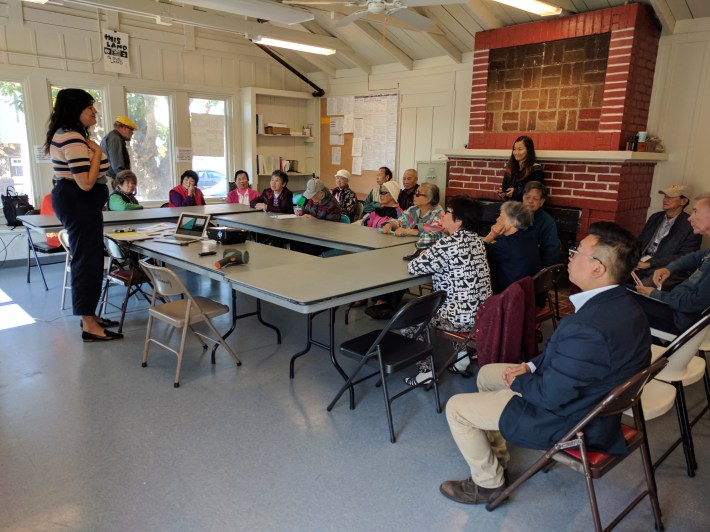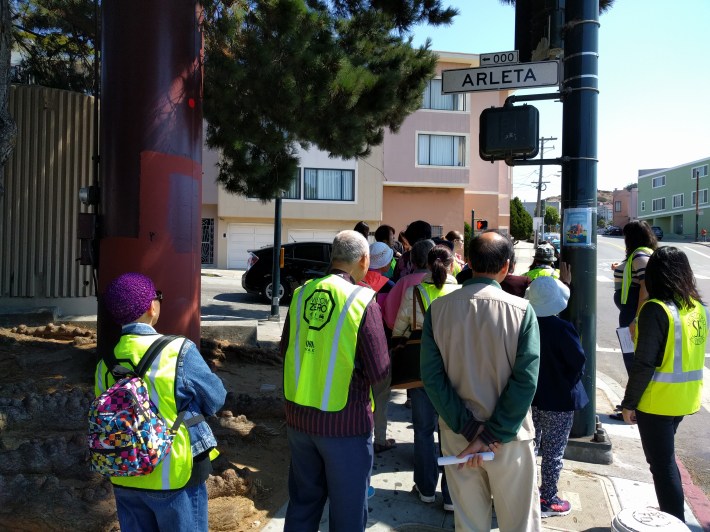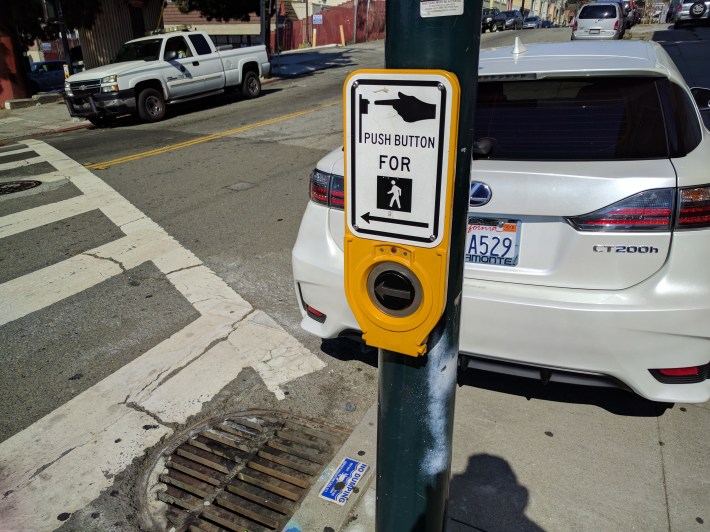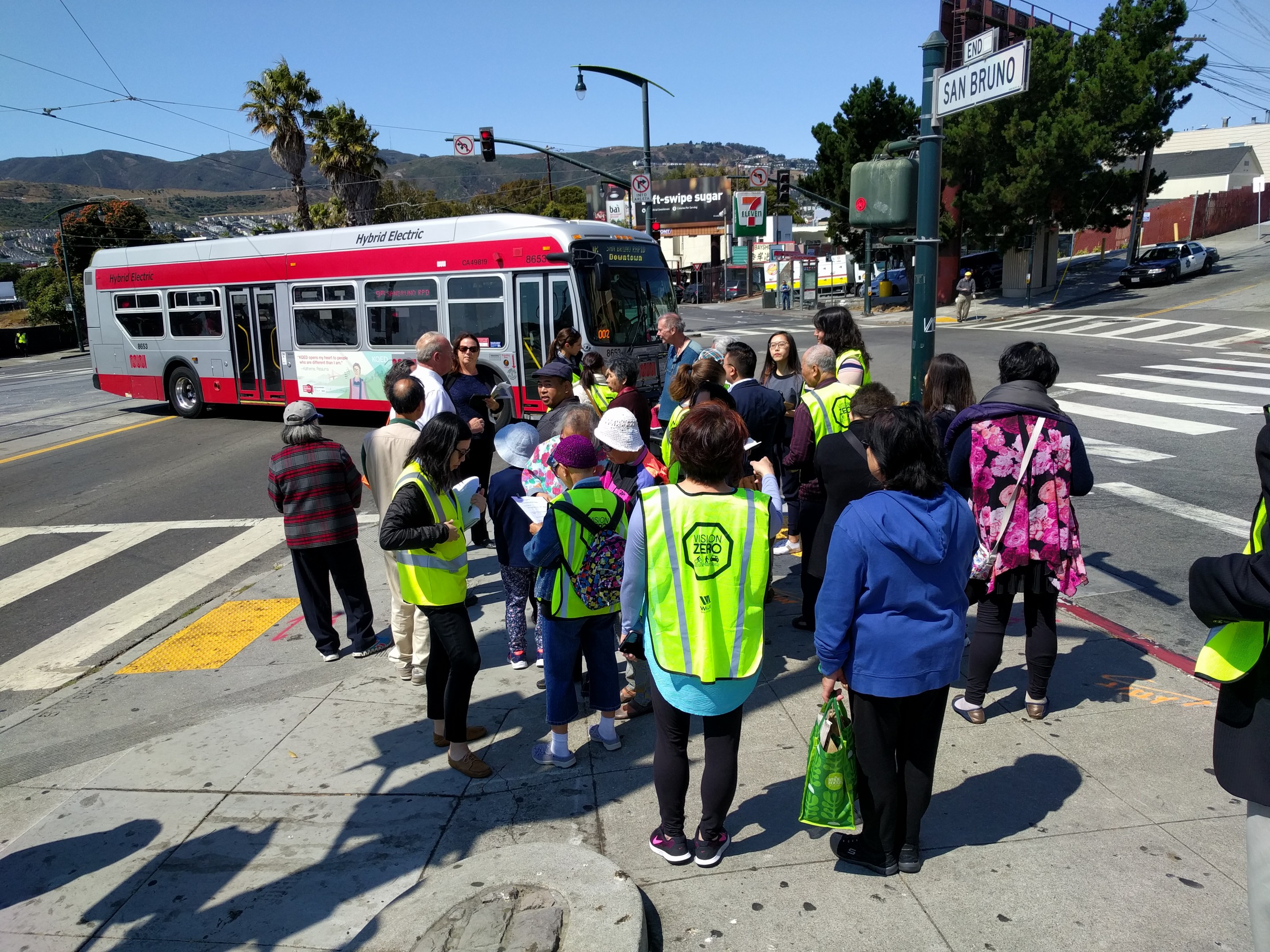Rex Tabora recalls the death of 82-year-old Oi Yeung in a crosswalk at Bayshore Boulevard and Visitacion Avenue, down the street from the Asian Pacific American Community Center (APACC), which he manages. "She was crossing the street on a green light and there was a vehicle making a left from Visitacion to Bayshore and she was killed," he said. "We have a lot of reckless drivers here."
And while reckless driving is dangerous and maddening for people who are still young and nimble, it is especially deadly for seniors who need extra time to cross. "They’re just not as mobile," said Tabora. When they do get hit, they're more likely to succumb to their injuries.
That's why advocates with Walk San Francisco are organizing seniors to push for safer streets in their communities. The first step in building a stronger advocacy voice is to get people informed. "Every day how many people do you think get hit in SF?" asked Natasha Opfell, Community Organizer for Walk SF, during a presentation yesterday morning to about 20 senior citizens at APACC. After pausing for Chinese translation, she heard a few guesses before giving the correct answer: "Three people a day get hit when walking--and that’s a lot."

Walk SF's strategy is to build a coalition of senior-citizens who can be called on for letter writing and phone campaigns, and who will show up at public meetings to demand better and safer pedestrian treatments. Opfell introduced the group to street engineering concepts. "Curb extensions and bulb outs. Has anyone seen them?" she asked, showing a photo of a bulbout as part of a PowerPoint presentation. "Oh yes," said someone in the audience. "These are helpful because they widen the corner so there’s less street to cross. And it lets the cars see you better. It also slows turning cars," she said. She also showed a picture of the raised crosswalk at the Stonestown Galleria, as well as other examples of safe-street treatments.
"Now you’re pedestrian safety experts," joked Opfell. But knowing some basic street engineering lets these student advocates request specific treatments from city officials and lawmakers. "You know the engineering tools in our tool box. Remember the ideas for our walk today."
Also at the meeting: Kenneth Chen of Assemblymember David Chiu's office, representatives from SFMTA, and two police officers, all there to hear from the seniors and to join a sort of walk-advocacy field trip to the nearby intersection of Arleta and Bayshore. That busy intersection is also a transfer point between the T-Third Light Rail Line and several bus lines and a known danger point for seniors attempting to use these transit services.

The group was given survey forms and the walk began. Before they even reached the intersection, Brian Desimas, who uses a walker, already had a specific complaint: cars parked on the sidewalk. "I counted 13 cars on the sidewalk last time I walked to the store," he said.
The group made its way north on Bayshore. Some serious engineering failures were obvious right away. There's a wide driveway to a 7-11 that invites cars to cut across the narrow sidewalks quickly. There's also a garbage can and bus shelter that block nearly the entire sidewalk.

The large group of seniors struggled through this obstacle course to the crossing with Arleta, only to find a beg button and countdown timer that doesn't give them nearly enough time to get across. And at almost every other cycle of the light, motorists were at least partially blocking the crosswalk. This, as Streetsblog has pointed out in a previous post, is a symptom of placing traffic signals too far forward. For seniors, it's a deadly problem--they don't have enough time to cross, and they have to navigate around cars blocking sidewalks and crosswalks. To get to the T-Third stop, seniors have to push a beg button, wait, cross Arleta, push another button and wait to cross San Bruno, and then push yet another button and wait again to cross Bayshore just to get to the station. The design of the crossing is so bad and dangerous for seniors that it almost seems, for lack of a better word, cruel.

Back at the senior center, Opfell did a debrief with the seniors. The room was animated, with seniors chatting away in English and Chinese. "The corners are too small!" said someone in the audience. "Muni bus drivers need to wait for people to cross!" said another. Opfell and others patiently recorded the comments and collected the survey results. At the end, they held a raffle and gave away some gift certificates to Walgreen's and other markets.
Clearly, the intersection needs major work. One participant in the walk suggested replacing it with a big traffic circle, something that might be a solution for a three-way intersection and a streetcar line. This video from the Bicycle Dutch website illustrates how that can work.
There are other off-the-shelf solutions, many of which will no doubt find support in the surveys. “Narrower travel lanes, speed humps, bulb-outs, and better timed crossing signals are proven solutions that calm traffic and slow speeding. Consistent implementation of these simple design treatments will save the lives of seniors and all road users," said Cathy DeLuca, interim executive director of Walk San Francisco.
In Streetsblog's view, re-timing the crossing countdowns, so that seniors can get across with room to spare, should be done immediately. “District 10 has a large population of seniors. Traffic crashes are a major danger to these community members who are five times more at risk of death than young adults, making Vision Zero safety improvements at Arleta and Bayshore critical,” said Supervisor Malia Cohen, in a statement about the meeting. Let's hope Cohen will push SFMTA to get this done. Because it's a matter of time before someone else is hurt or killed on this stretch of road.





